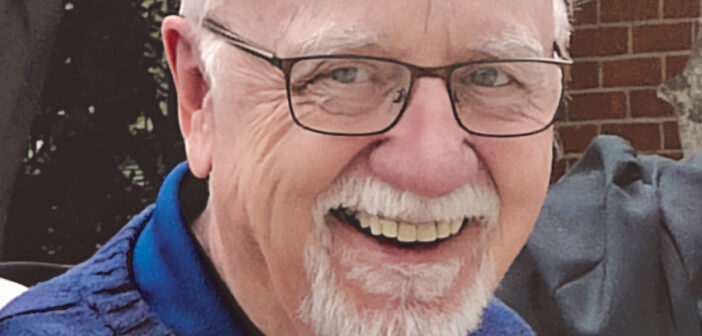“Water color is a swim in the metaphysics of life … a mirror of one’s own character. Let it be unpredictable and colorful.”
~Anonymous
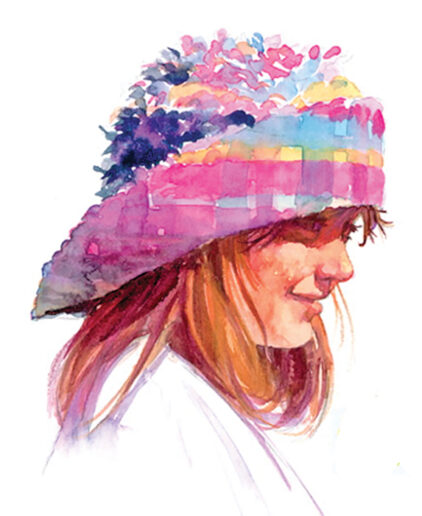
Jim featured this watercolor in his book to demonstrate how to paint a full color painting with just the three CMY primary paints (although he used several paints in this piece).
To Jim Ames of Flint, color is everything. At 86, the graphic designer, illustrator, fine art painter and watercolor artist teaches watercolor and acrylic painting at the Flint Institute of Arts. He has given lectures on color at many leading U.S. art schools and with the help of son-in-law Ed Chiles, also does the layout and design for two General Motors publications.
His proudest achievement, however, is the book he authored and published in the ‘90s, Color Theory Made Easy, which has sold 24,000 copies worldwide. The book explains how to mix colors using 15 artist paint colors in relation to the Ames Colorwheel he created. “The book discusses watercolors, color theory, and art in general,” he says.
Born and raised in Algonac, MI Ames was drafted into the Army when he was 22 years old. He had a background in art having worked as an apprentice in Detroit and did artwork while in the Army. “I always wanted to succeed as a commercial artist,” he remembers.
The young artist came to Flint in 1961 and worked as a commercial artist at Curtis Printing while living at the YMCA. He married his late wife, Diane, in 1962 and the couple moved to Brown City, MI where he was offered a job designing motorhome interiors. They stayed there for a year and moved back to Flint, where he met many people involved in the arts community. He was then offered a designer/illustrator job in Saginaw and commuted to work there for five years. “It was the biggest art studio at the time,” he notes.
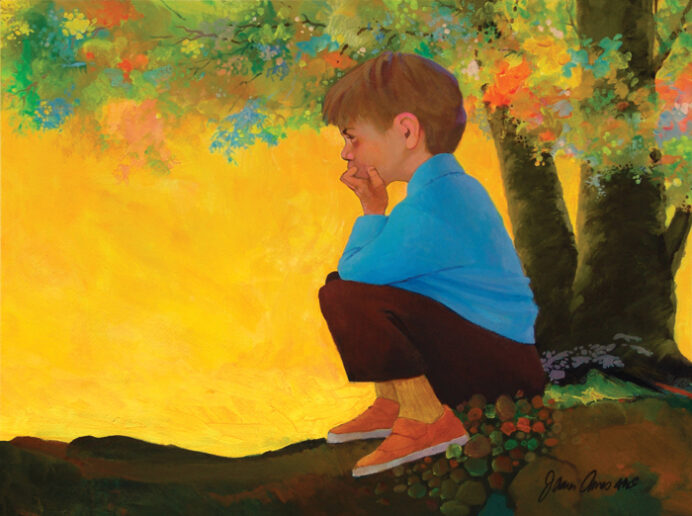
This painting was first created almost 50 years ago in what Ames calls his “Andrew Wyeth period – the less the color, the better.” He recently repainted the background, with the brightly-colored leaves meant to portray a youthful dreamer.
In 1972, Ames founded his graphic arts studio, Jim Ames Studio, which celebrated its 50th anniversary in 2022. Ames decided he wanted to work with watercolor and it took him five years, but he became a member of the American Watercolor Society, a very prestigious organization. This is when he wrote his book, which was eventually out of print; but in 2017 he wrote an updated and improved version which is still being sold today.
Ames was young, in his 30s, when he became a watercolor instructor at the Flint Institute of Arts (FIA) and is still going strong, teaching twice a week to this day. “People come to the classes from all over!” Ames exclaims. And, he is proud to have taught students who are now well-known artists.
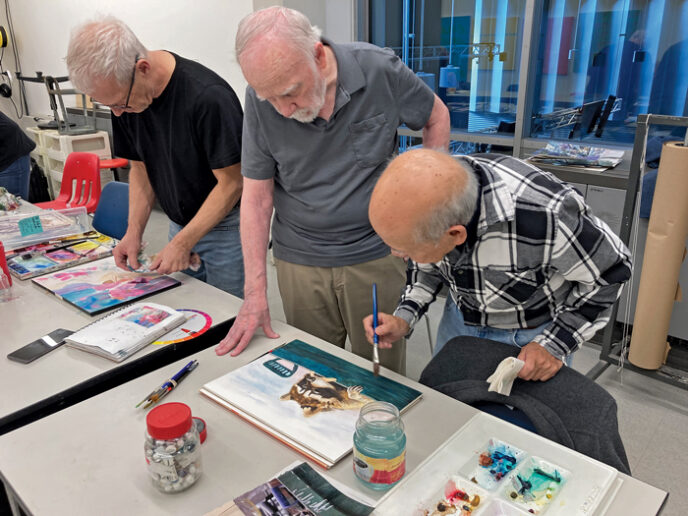
Jim Ames (center) has taught art at FIA for around 50 years.
Accomplished Watercolor Artist Anni Crouter was one of those students. “Anni took my class many years ago and she also teaches at FIA,” Ames says. Crouter credits Ames, her longtime mentor, for her success. It was reported that “under his guidance her knowledge in art theory and artistic abilities has continually progressed, and now her work can be seen in national and international trade journals, art galleries and businesses in several states, and in the homes of private collectors.”
“Art is my whole life! I like to help other artists get better.”
– Jim Ames
Another very talented artist, Rich Tesner, helps Ames teach the watercolor class at FIA on Fridays. “I enjoy teaching,” Ames shares. “I like to help other artists get better.”
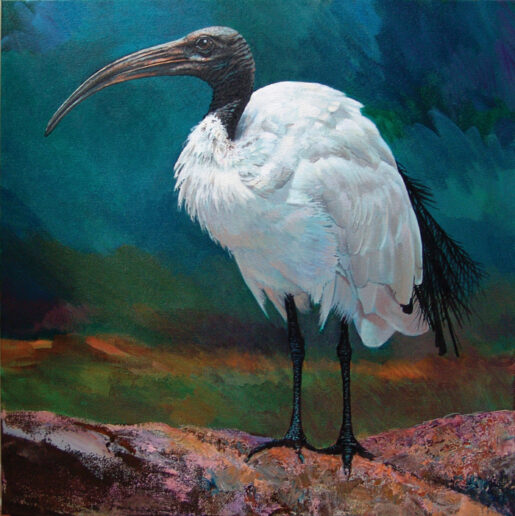
The challenge with this piece (acrylic) was “to paint the white feathers with color.”
How did Ames become interested in art? “I was born with it; it is a natural talent,” he admits. “If you have a natural talent, it never goes away. Not everyone is an artist. You either have it or you don’t.”
What does art mean to Ames? “It’s my whole life!” he exclaims. What he is most proud of is teaching others what he knows. He recently ran into a doctor in Saginaw who had taken one of his classes. “She couldn’t say enough about how much she learned. That’s what makes it all worthwhile – that and seeing Anni (Crouter) become a world renowned artist.”
As for his long and successful career as an artist and educator, Ames offers a final thought: “It’s amazing to me that I’m still going!”
Color Theory Made Easy
 This book presents an alternative approach that cuts through the tangle of established but contradictory concepts to give artists a universal theory that really applies to their work. Most artists are taught that red, blue and yellow are the primary color hues that cannot be created from any combination of other colors. However, as a result of years of study, author and artist Jim Ames has concluded that the true primary colors are cyan (a greenish blue), magenta (a violet red) and a yellow that does not lean toward either cyan or magenta. In Color Theory Made Easy, Ames explains the importance of these three colors as the basis for all of our thinking about color.
This book presents an alternative approach that cuts through the tangle of established but contradictory concepts to give artists a universal theory that really applies to their work. Most artists are taught that red, blue and yellow are the primary color hues that cannot be created from any combination of other colors. However, as a result of years of study, author and artist Jim Ames has concluded that the true primary colors are cyan (a greenish blue), magenta (a violet red) and a yellow that does not lean toward either cyan or magenta. In Color Theory Made Easy, Ames explains the importance of these three colors as the basis for all of our thinking about color.
The Ames COLORWHEEL*
The 8.5-inch circular colorwheel has a movable dial on both sides. There are
24 pure hue colors located on the outside edge of the wheel. The front-side is 100% pure hues. The cut-out on the front-side dial shows 30% and 50% shades of the selected color. All the colors come from various percentages of cyan, magenta and yellow (CMY). The three circular codes show the percentages of CMY of the selected color. The back-side displays 50% tints of the 24 pure hues.
*Source: jimamescolortheory.com

